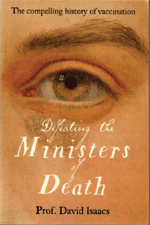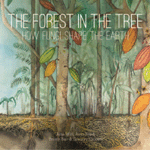Book reviews
Microbiology Australia 41(4) 224-224 https://doi.org/10.1071/MA20059
Published: 22 October 2020
Defeating the Ministers of Death. The Compelling History of Vaccination

|
Author: David Isaacs
Publisher: HarperCollins, Sydney, 2019
Paperback ISBN 978 14607 5684 3. 357 pages, including comprehensive footnotes and an index. Also available as an e-book.
David Isaacs, an Australian paediatrician and infectious diseases specialist, has written an enchanting, enthralling and comprehensive account of the history, impact and shortcomings of vaccines for diseases of humans.
This personal account is filled with wonderful anecdotes, matched by a finely tuned sense of humour. Particularly notable is Isaacs’ even-handed, thoughtful approach to the ethics of immunisation, the anti-vaccination movement and the burden that poverty imposes on access to vaccines. Although factual and teeming with useful information, this work is easily accessible and highly recommended for lay people and students of all ages, as well as for professional microbiologists.
Vaccines represent the greatest achievement of modern medicine, having saved many millions of lives. Even more impressive is the ability of vaccines to eradicate devastating diseases, exemplified by smallpox, with more on the cards. The current COVID-19 pandemic has reminded us of the importance of infection control and our reliance on immunisation to combat infections in the long term. I am looking forward to the second edition of Isaacs’ book with a new chapter on how medical science defeated SARS-CoV-2.
Reviewed by Roy Robins-Browne, Department of Microbiology and Immunology, Peter Doherty Institute for Infection and Immunity, The University of Melbourne
The Martin Spirit: Charles Martin and the Foundation of Biological Science in Australia

|
Author: Patricia Morison
Publisher: Halstead Press
Paperback ISBN 978 1925043 471. 292 pages including comprehensive footnotes, Bibliography and an index.
Martin Gibbs, Charles Martin’s grandson, gave the author access to 40 years of correspondence with his daughter Maisie, and to his letter books as an officer in the Australian Army Medical Corps. The outcome, following extensive additional research, is a very intimate and insightful study of an entirely remarkable and yet almost forgotten figure in the history of biomedical science in Australia.
Most Australian biomedical researchers will no doubt be familiar with the CJ Martin scholarships, but probably have no idea of the man after whom they are named. Patricia Morison’s meticulously researched book on CJ Martin aims to redress that issue.
Martin left school at 15 and began work as a junior clerk in his father’s business but hankered to study medicine. Eventually he achieved this goal, and after graduation another, to marry, by taking up a position as a Demonstrator in Physiology at Sydney University. During his 12 years in ‘the colony’, where he played a pivotal role in the development of medical courses in both Sydney and Melbourne, his mantra was that to learn Science the student needed to experience it.
Martin returned to London to head up the Lister Institute for 27 years but never forgot his Australian mates, joining the AIF to combat infectious diseases at Gallipoli and in later years serving CSIR(O). His work with troops during the First World War exemplifies why Science must always be the basis for informed decisions about life and its dilemmas.
Martin loved Australia and made a lasting contribution to Australian science. The Martin Spirit is not only a fascinating account of the man and his work but also of the many Australian scientists who he inspired and mentored. I commend Patricia Morison for her mammoth effort for breathing life into The Martin Spirit and bringing it to our notice in such vibrant and intricate detail.
Reviewed by Ross Barnard, School of Chemistry and Molecular Biosciences, Australian Infectious Diseases Research Centre and ARC Training Centre for Biopharmaceutical Innovation, The University of Queensland and Cheryl Power, Department of Microbiology and Immunology, Peter Doherty Institute for Infection and Immunity, The University of Melbourne
The Forest in the Tree: How Fungi Shape the Earth

|
Authors: Ailsa Wild, Aviva Reed, Briony Barr, Gregory Crocetti
Publisher: CSIRO Publishing
Hardback ISBN 978 1486313310. 48 pages
This book is the fourth book in the Small Friends Books series (https://www.publish.csiro.au/books/series/81) and its focus earns respect for amazing soil fungi and the role they play in ecosystems. It engages readers by telling a story of growth and drought survival from a fungal spore’s perspective. Its symbiosis with a cacao tree is clearly and attractively illustrated. It is targeted for readers aged 8–12 years, teachers, librarians and parents. Learning is enhanced by a set of freely downloadable teacher notes and questions, making this a valuable learning resource.
Reviewed by Ian Macreadie, School of Science, RMIT University


